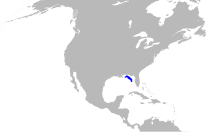| Rice's whale | |
|---|---|

| |
| Rice's whale surfacing in the Gulf of Mexico | |

| |
| Size compared to an average human | |
| Scientific classification | |
| Domain: | Eukaryota |
| Kingdom: | Animalia |
| Phylum: | Chordata |
| Class: | Mammalia |
| Order: | Artiodactyla |
| Infraorder: | Cetacea |
| Family: | Balaenopteridae |
| Genus: | Balaenoptera |
| Species: | B. ricei
|
| Binomial name | |
| Balaenoptera ricei Rosel et al., 2021
| |

| |
| Core range as of June 2019 | |
| Synonyms | |
| |
Rice's whale (Balaenoptera ricei), also known as the Gulf of Mexico whale, is a species of baleen whale endemic to the northern Gulf of Mexico. Initially identified as a subpopulation of the Bryde's whale, genetic and skeletal studies found it to be a distinct species by 2021. In outward appearance, it is virtually identical to the Bryde's whale. Its body is streamlined and sleek, with a uniformly dark charcoal gray dorsal and pale to pinkish underside. A diagnostic feature often used by field scientists to distinguish Rice's whales from whales other than the Bryde's whale is the three prominent ridges that line the top of its head. The species can be distinguished from the Bryde's whale by the shape of the nasal bones, which have wider gaps due to a unique wrapping by the frontal bones, its unique vocal repertoire, and genetic differences.
It is a medium-sized baleen whale that grows up to 12.65 meters (41.5 ft) in length and weighs up to 13.87–27.2 metric tons (13.65–26.77 long tons; 15.29–29.98 short tons). The Rice's whale inhabits a restricted stretch along the continental slope in the northeastern part of the Gulf of Mexico between depths of 150–410 meters (490–1,350 ft) off the coast of western Florida, although some whales have been sighted in the northwestern portions and the species may have inhabited a wider distribution throughout the Gulf in historical times. It does not migrate but remains within this area year-round. Little is known about the feeding behavior of Rice's whales, but data from a tagged individual revealed a diel vertical diving pattern, in which the whale spends most of the day feeding at or near the seafloor at depths of up to 271 meters (889 ft) and night at the surface. The whale's diet remains unknown, but lanternfish and hatchetfish are suspected prey.
The Rice's whale is on the brink of extinction and, alongside the vaquita, is one of the most endangered cetaceans in the world. It is listed as Critically Endangered in the IUCN Red List and protected under the United States Endangered Species Act. The best population estimate is 33, with as little as 16 mature individuals, and the population is continuing to decline. The reasons why the species' population declined to its current state remain poorly understood, but scientists believe that the industrialization of the Gulf of Mexico and the increase of anthropogenic activities within its habitat are primary contributors; unlike most baleen whales it is unlikely that whaling had an impact. Today, the Rice's whale's main threats are related to industrial and commercial activities within its habitat, including oil pollution, ship collisions, and underwater noise from seismic surveys and vessel traffic. It has also shown to be especially vulnerable to local catastrophic events such as the 2010 Deepwater Horizon oil spill, which single-handedly killed nearly twenty percent of the species' population.
- ^ Corkeron, P.; Reeves, R.; Rosel, P. (2017). "Balaenoptera edeni (Gulf of Mexico subpopulation)". The IUCN Red List of Threatened Species. 2017: e.T117636167A117636174. doi:10.2305/IUCN.UK.2017-3.RLTS.T117636167A117636174.en.
- ^ "Appendices | CITES". cites.org. Retrieved 2022-01-14.
